
The history of Peru spans 15 millennia, extending back through several stages of cultural development along the country's desert coastline and in the Andes mountains. Peru's coast was home to the Norte Chico civilization, the oldest civilization in the Americas and one of the six cradles of civilization in the world. When the Spanish arrived in the sixteenth century, Peru was the homeland of the highland Inca Empire, the largest and most advanced state in pre-Columbian America. After the conquest of the Incas, the Spanish Empire established a Viceroyalty with jurisdiction over most of its South American domains. Peru declared independence from Spain in 1821, but achieved independence only after the Battle of Ayacucho three years later.

José Simón Pardo y Barreda was a Peruvian politician who served as the 35th (1904–1908) and 39th (1915–1919) President of Peru.

The Historic Centre of Lima is the historic city centre of the city of Lima, the capital of Peru. Located in the city's districts of Lima and Rímac, both in the Rímac Valley, it consists of two areas: the first is the Monumental Zone established by the Peruvian government in 1972, and the second one—contained within the first one—is the World Heritage Site established by UNESCO in 1988, whose buildings are marked with the organisation's black-and-white shield.
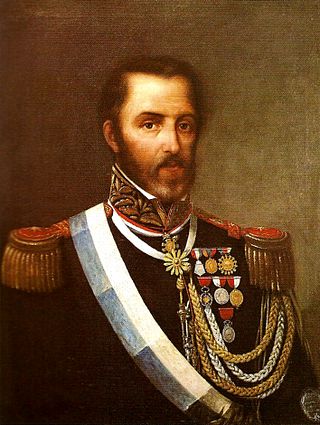
Juan Galo Lavalle was an Argentine military and political figure from the Unitarian Party.
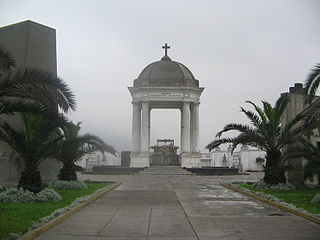
Presbyter Matías Maestro Cemetery, formerly the General Cemetery of Lima, is a cemetery, museum and historical monument located in the Barrios Altos neighbourhood of Lima District, in Lima, Peru. Inaugurated on May 31, 1808, it was the first pantheon in the city since burials were previously held in the city's churches. It was named in honour of its designer, Spanish priest Matías Maestro.

The Ministry of Economy and Finance of Peru is the government ministry responsible for the planning and execution of economic policies of the Peruvian government with the goal of optimizing the economic and financial activities of the state, establish macroeconomic activity, and achieve the sustainable growth of the nation's economy. As of 2024, the minister of Economy and Finance is José Arista.

Pedro José de Zavala y Bravo de Ribero, 7th Marquess of San Lorenzo del Valleumbroso, OIC, KOC, was a Spanish-Peruvian nobleman and soldier.
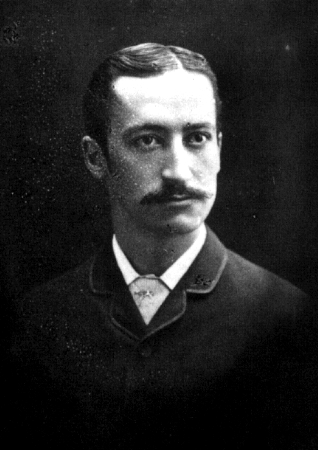
José Antonio de Lavalle y Arias de Saavedra was a Peruvian diplomat, writer and historian. He was Minister Plenipotentiary to Germany, Russia, Chile and Brazil and minister of Foreign Relations. He is known for having led the Peruvian Mission to Chile before the War of the Pacific and for signing Treaty of Ancón.
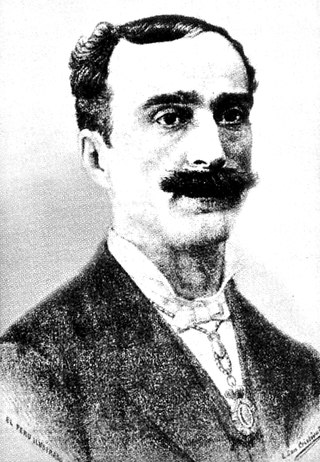
Manuel Eugenio Larrabure y Unanue was a Peruvian politician, diplomat, writer, historian and journalist. He was thrice Minister of Foreign Affairs, Minister of Development and Public Works, President of the Council of Ministers and First Vice President.
Anarchism in Peru emerged from the Peruvian trade union movement during the late 19th century and the first two decades of the 20th century.

Carlos Ferreyros y Senra was a Peruvian Navy officer and politician. He was the commander of the gunboat Pilcomayo during the War of the Pacific, commanding it before its capture. He was also a Senator of the Department of Huánuco from July 28, 1907, to February 6, 1910, where he died in office.

The Palacio de la Magdalena is a viceregal house located in the district of Pueblo Libre in Lima. It is located near the Plaza de los Libertadores, and is also known as the Quinta de los Libertadores. The building was declared a national monument in 1972.

José Gabriel Gálvez Egúsquiza was a Peruvian lawyer, professor and liberal politician. During the presidential government of Mariano Ignacio Prado he was Secretary—i.e. Minister—of War and Navy (1865). He was killed in action during the Battle of Callao, where he died fighting the Spanish squadron, thus becoming a symbol of the independence of America.

The National Club is a private club and civil association based in the Plaza San Martín of the Historic Centre of Lima. Founded on October 19, 1855, it has been the meeting place for the Peruvian aristocracy throughout the 19th and 20th centuries, as its members are members of the most distinguished and wealthy families in the country.
José Antonio de Lavalle y Pardo was a Peruvian lawyer and politician.
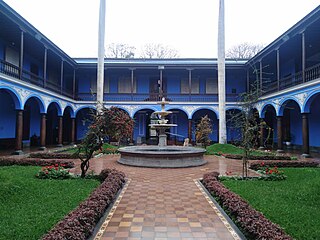
The Real Convictorio de San Carlos, or Convictorio de San Carlos after independence, was a college in Lima created at the end of the Viceroyalty of Peru and which survived until the first decades of the Peruvian Republic.

Jirón Augusto Wiese, better known as Jirón Carabaya, is a major street in the Damero de Pizarro, located in the historic centre of Lima, Peru. The street starts at its intersection with the Jirón Áncash, and ends at the Paseo de la República.

José Rafael Ernesto Marquina y Bueno was a prominent Peruvian architect during the early 20th century. His contributions to Peruvian architecture remain to this day in the city's historic centre, having also contributed as an educator at the School of Fine Arts and the School of Engineers.




















